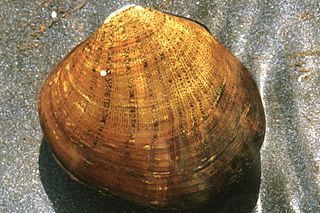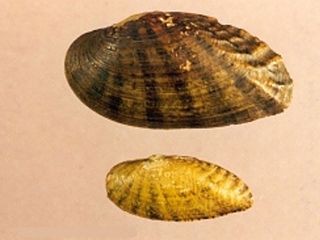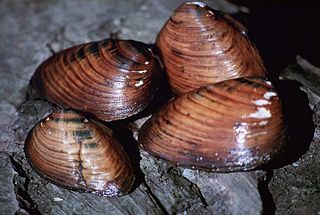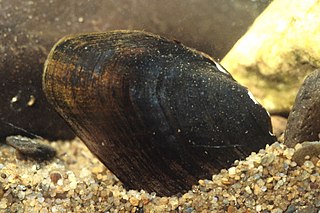
The slender chub is a species of ray-finned fish in the family Cyprinidae. It is found only in the United States, within the Clinch and Powell rivers. It is likely extirpated from the Holston River, having last been observed there in 1941. Due in part to a lack of targeted surveys, slender chub have not been definitively observed since the 1990s. The 2021 5-year review of this federally threatened species recommended environmental DNA sampling in future surveys with comparison to DNA extracted from preserved specimens.

Dromus dromas, the dromedary pearlymussel or dromedary naiad, is a rare species of freshwater mussel in the family Unionidae. This aquatic bivalve mollusk is native to the Cumberland and Tennessee River systems in the United States, where it has experienced a large population decline. It is a federally listed endangered species of the United States.

Epioblasma turgidula, the turgid blossom pearly mussel, turgid riffle shell, turgid-blossom naiad or turgid blossom, was a species of freshwater mussel, a mollusk in the family Unionidae. The US Fish and Wildlife Service declared the species extinct and delisted it from the Endangered Species Act.

Fusconaia cuneolus, the fine-rayed pigtoe pearly mussel or fine-rayed pigtoe, is a species of bivalve in the family Unionidae. It is native to Tennessee, Alabama, and Virginia in the United States, in each of which its population has declined severely. It is a federally listed endangered species of the United States.

The birdwing pearlymussel is a rare species of freshwater mussel in the family Unionidae, the river mussels. This aquatic bivalve is native to Tennessee and Virginia in the United States. Its range has declined over 90%. It is a federally listed endangered species of the United States.

Medionidus acutissimus, the Alabama moccasinshell, is a species of freshwater mussel in the family Unionidae, the river mussels. It is native to Alabama, Mississippi, Georgia, Tennessee, and possibly Florida. It is a federally listed threatened species of the United States.

Medionidus penicillatus, the gulf moccasinshell, is a rare species of freshwater mussel in the family Unionidae, the river mussels. This aquatic bivalve mollusk is native to Alabama, Florida, and Georgia in the United States, where it is in decline and has been extirpated from most of the rivers it once inhabited. It is a federally listed endangered species of the United States.

Obovaria retusa is a rare species of freshwater mussel in the family Unionidae, the river mussels. Its common names include golf stick pearly mussel and ring pink.

Pleurobema clava, the clubshell, club naiad or clubshell pearly mussel, is a species of freshwater mussel, an aquatic bivalve mollusk in the family Unionidae, the river mussels.
Pleurobema marshalli, the flat pigtoe or Marshall's mussel, was a species of freshwater mussel in the family Unionidae, the river mussels. It was native to Alabama and Mississippi, but it has not been seen since 1980. Though it is still listed as critically endangered on the IUCN Red List and as an endangered species on the US Endangered Species List, it is likely extinct.

Pleurobema oviforme, the Tennessee clubshell, is a species of freshwater mussel in the family Unionidae, the river mussels. It is native to the eastern United States, where it occurs in Alabama, Kentucky, North Carolina, Tennessee, and Virginia. It also previously occurred in Mississippi.

Theliderma intermedia, the Cumberland monkeyface pearly mussel or Cumberland monkeyface, is a species of freshwater mussel in the family Unionidae, the river mussels. This aquatic bivalve mollusk is native to Tennessee and Virginia in the United States. Historically widespread in the upper Tennessee River system, it populations have been reduced by habitat destruction and pollution. It now only occurs in two tributaries: the Duck and Powell Rivers. It is a federally listed endangered species.
Theliderma stapes, the stirrup shell or stirrupshell, was a species of bivalve in the family Unionidae. It was endemic to eastern Mississippi and western Alabama in the United States. It was last observed in 1987 and was proposed for delisting due to extinction by the US Fish and Wildlife Service in 2021. It was officially declared extinct on October 16, 2023.

Toxolasma cylindrellus, the pale lilliput naiad, pale lilliput pearly mussel, or pale lilliput, is a species of freshwater mussel, an aquatic bivalve mollusk in the family Unionidae, the river mussels. Its host is the northern studfish.

Villosa trabalis, the Cumberland bean pearly mussel, Cumberland bean, or purple bean, is a species of freshwater mussel, an aquatic bivalve mollusk in the family Unionidae.

The rabbitsfoot is a species of freshwater mussel. It is an aquatic bivalve mollusk, in the family Unionidae, the river mussels.

The warpaint shiner is a species of freshwater fish found in North America. It is common in the upper Tennessee River basin as well as in the Savannah River, the Santee River, and the New River in North Carolina. Adults have a mean length of 9 centimetres (3.5 in) and can reach a maximum length of 14 centimetres (5.5 in). The maximum age reported for this species is 4 years.
Spotfin chub is a ray-finned fish in the family Cyprinidae that is endemic to the Tennessee River watershed. Its other common names include turquoise shiner and chromium shiner.
The Ozark chub is a species of ray-finned fish in the family Cyprinidae. It is found in medium-gradient streams in the Ozarks in Missouri and Arkansas. A petition for federal protection under the Endangered Species Act was rejected by the U.S. Fish and Wildlife Service in 2019 due to the species' continued presence in most of the waterways it is historically known from.
















